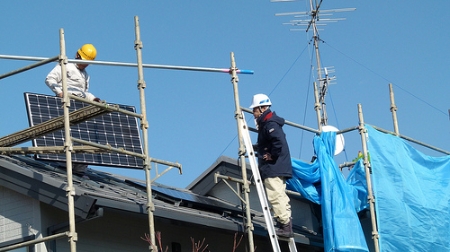By Meg Cichon
Peterborough, NH, USA — Prices dropped, installations soared, and capacity surged in what proved to be a prosperous year for the solar industry, according to the 2010 U.S. Solar Market Trends Report released late last month by the Interstate Renewable Energy Council (IREC). This may be great news for the industry, but while the road seems stable now, there are still some hazards to navigate in the distance.
The report details public data on solar installations in the U.S. by technology, state and market sector. These sectors include photovoltaic (PV), concentrating solar power (CSP) and solar heating and cooling.

Solar PV was the clear front-runner in 2010, as installations doubled from the previous year to 890 MW: 262 MW were residential, 374 MW were commercial and 384 MW were in the utility sector. More than 50,000 installations, a 45 percent increase from 2009, raised the total installed grid capacity to 2.15 GW. The report speculates that this growth is the result of stable state and federal incentives, federal stimulus funding, improved capital markets, state renewable portfolio standards (RPS) and PV module price decline.
Residential installations were extremely popular in 2010 and contributed to 91 percent of the 50,000 installations. The average size of grid-connected residential PV grew from 2.9 kW in 2001 to 5.7 kW in 2010. The average system size for utility-scale solar PV is over 1.45 MW.
The top states for installed PV were California, New Jersey, Nevada, Arizona and Colorado. And the market more than doubled for many of the top 10 states, including Nevada, New Mexico, and Texas. The newcomers were added to this year’s list due to one large installation in each state. Nevada installed a 58-MW plant for Pacific Gas and Electric, the largest in the U.S., New Mexico had a 35 MW installation that provides power for Tri-State Generation customers in five states, and Texas installed a 17-MW plant that provides power for CPS Energy.
The report suggests the future for CSP looks positive. Florida Power and Light installed a 75 MW CSP plant in 2010, the largest since the 1980s, but numerous projects are in the pipeline. “There is clearly a lot of CSP in the pipeline, way more than what has been installed in the last few years,” said Larry Sherwood, author of the report. “My guess is that people are trying feverishly to get construction started this year on most of those plants due to the treasury cash grant,” he said. The 1603 cash grant in lieu of tax credit provides the 30% investment tax credit as an up front payment to developers but is set to expire at the end of the year. Projects may still be eligible for additional local and state tax credits, as well.
The solar heating and cooling space is still lagging behind the PV market. The report estimates that installations have only increased by six percent since 2009. This small growth is attributed to unstable incentive programs. “The solar water-heating markets respond when federal incentives are increased, but, unlike photovoltaic installations, market demand does not sustain high growth rates,” according to the report. Although some states (Arizona, California, Connecticut, Florida, Hawaii and others) provided rebates in 2010, the report suggests that they weren’t enough to affect growth on a national level.
“The solar thermal market just isn’t as dynamic as the PV market,” said Sherwood. “The systems are smaller and probably more complicated to install, so they just haven’t attracted the same imagination from installation companies to promote it and customers to use it.”
The rebate amounts are also much smaller in relation to PV, which is a likely explanation for the slow growth. But another major reason solar thermal is lacking is strong competition from other industries. “The economics of solar hot water are often challenging in places where natural gas is used around the country,” said Sherwood. Unlike the competitive prices of coal and solar PV for electricity, natural gas is still much cheaper than solar hot water.
Despite solid growth in 2010 and an expected upward trend in 2011, uncertainties remain for the solar sector.
Sherwood is hopeful for 2011, as the report suggests that PV growth will continue with higher rates for utility-scale projects. And in order to drive this market growth, the report states that we will see continued reduction in PV prices, stable extension of federal incentives, and possibly new laws that will allow utilities to take advantage of more incentives.
“The economy is slowly but surely getting a little stronger and it’s a little easier to get financing. And there are a lot of systems in the pipeline ready to take advantage of the cash grant before it expires,” said Sherwood.
If the grant expires, though, Sherwood is less optimistic. “Basically, if the grant is not extended there will be a surge of people starting projects at the end of this year…it will potentially have an impact on new projects starting in the future, but that would impact 2012 and beyond,” he said.
Watch Larry Sherwood detail the 2010 Solar Market Trend Report in the video below:
 Follow
Follow